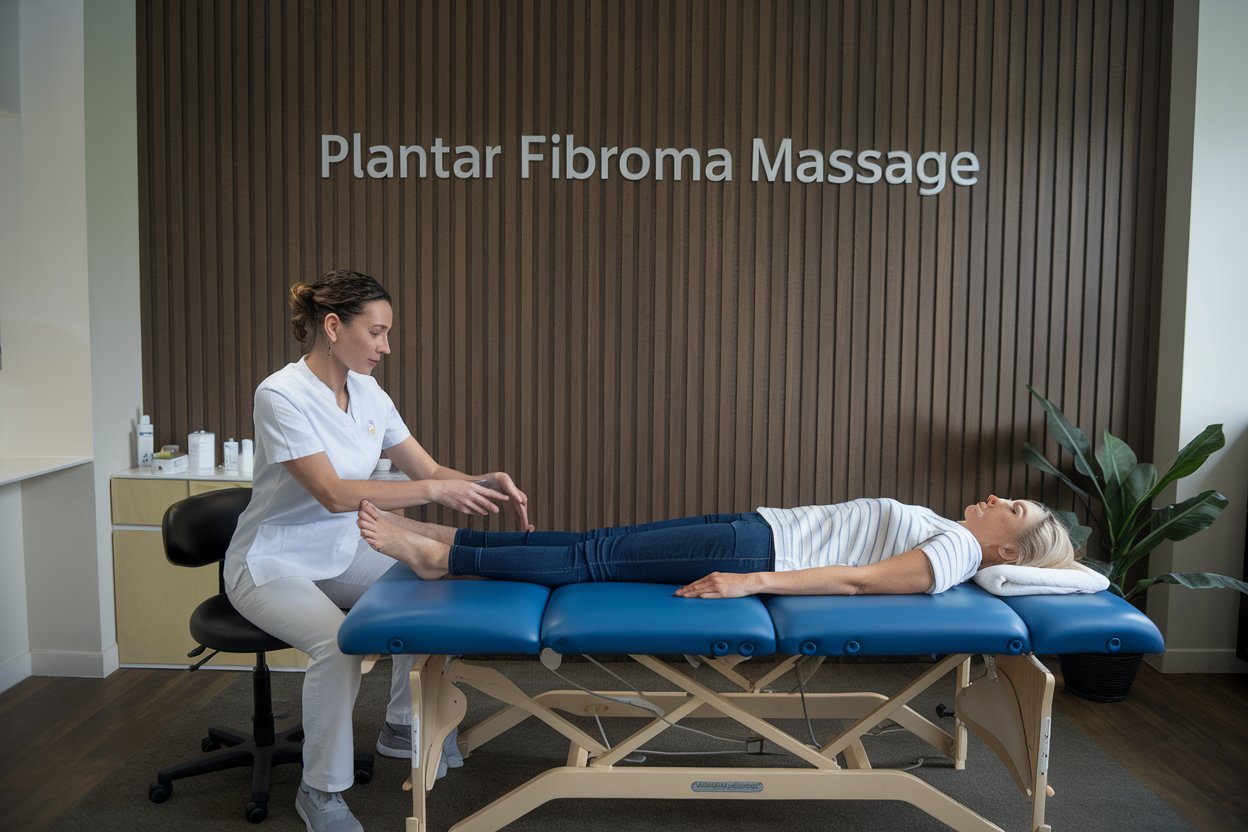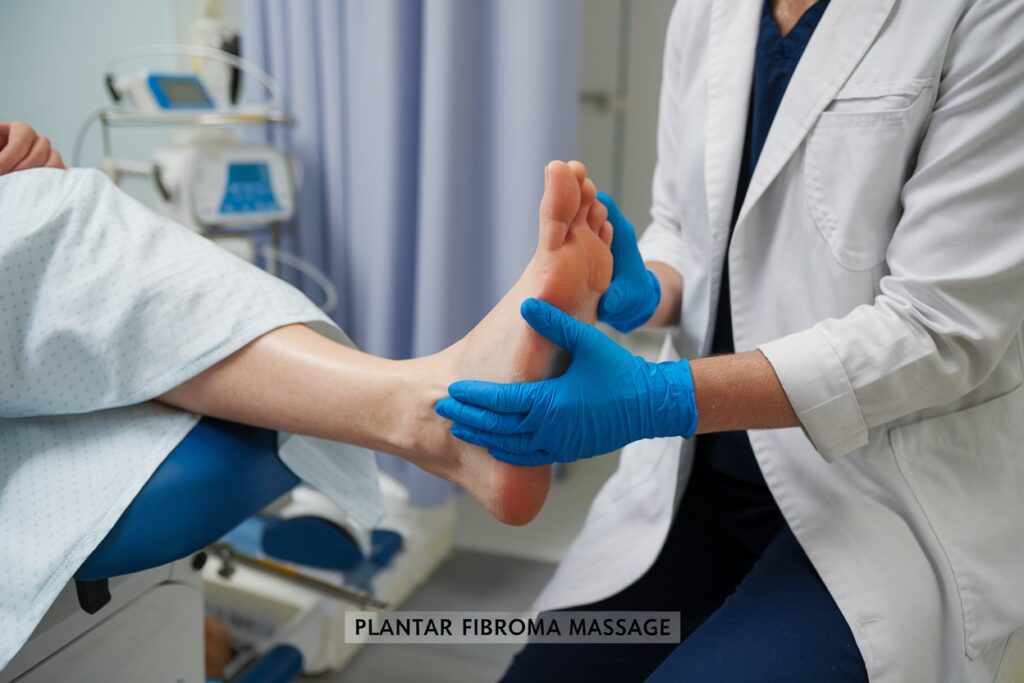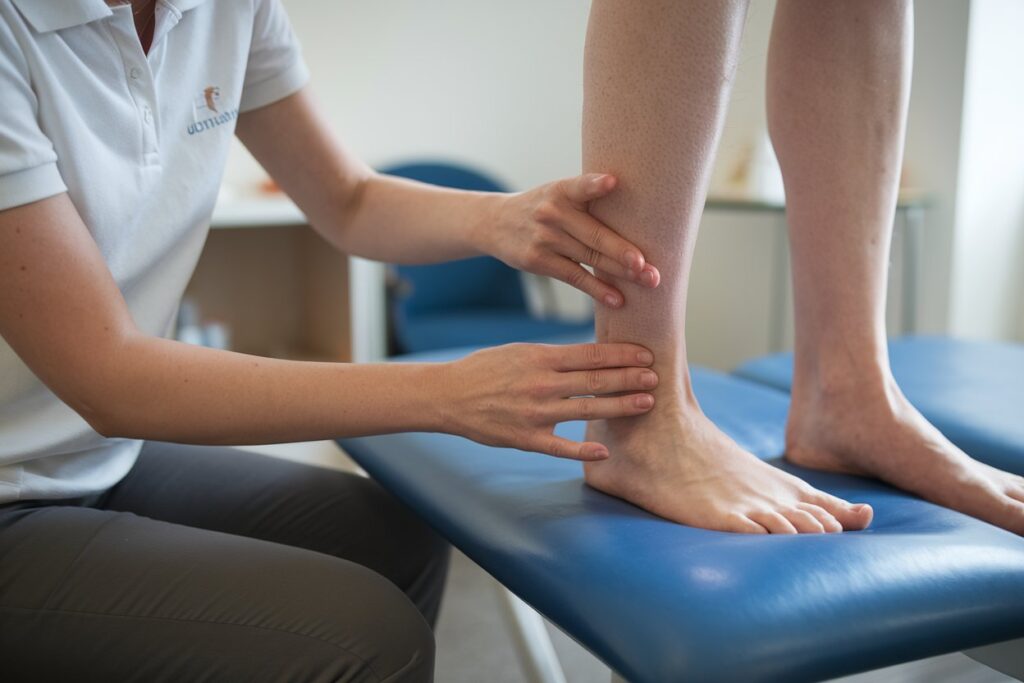Soothing Plantar Fibroma Massage Techniques

Meet Lisa, a dedicated runner who always put her health first. But after years of running, she felt a painful lump in her foot’s arch. Her doctor told her it was a plantar fibroma, and she was worried.
Lisa tried many treatments to find relief. But it wasn’t until she found plantar fibroma massage that things got better. This massage helped ease her pain and improve her foot’s circulation and mobility.
Massage became key to Lisa’s plantar fibroma treatment. It made her feel better right away. And it helped her stay active without letting her condition slow her down.
This article will show how plantar fibroma massage helps with plantar fibroma relief. We’ll also share ways to add it to your self-care. If you’re dealing with this issue, let’s explore these techniques together.
For the best care, talk to a professional therapist. They can help you a lot. Check out more info here.
Table of Contents
Understanding Plantar Fibroma
A plantar fibroma is a harmless growth in the plantar fascia, the tough tissue on the foot’s bottom. These nodules can appear in one or both feet, mostly in adults between 20 and 60 years old. It’s important to know that these growths are not harmful.
Even though they’re harmless, plantar fibromas can cause pain and discomfort, especially when you walk. People with these growths often feel pain in the foot’s arch. Knowing where they are helps find ways to deal with them.
Plantar fibromas might not go away by themselves. Trying massage as a first step to ease symptoms is an option. But, it’s best to talk to a doctor before starting any treatment. This ensures the chosen method will help with the pain.
| Characteristic | Description |
|---|---|
| Nature | Benign growth |
| Common Age Range | 20 to 60 years |
| Location | Within the plantar fascia |
| Symptoms | Pain, discomfort, and tenderness |
| Treatment Options | Physical therapy, orthotics, massage, surgery |
Learning about plantar fibroma helps in finding the right treatment. For those looking to boost their sexual confidence and overcome performance anxiety, exploring healthy habits can be helpful
Symptoms and Causes of Plantar Fibroma
People with plantar fibroma notice a lump on the foot’s arch. This lump can cause a lot of pain, especially when you put pressure on it. Luckily, many cases don’t need surgery to feel better.
The reasons behind plantar fibromas are not fully known. But, some ideas exist. One idea is that stress and small tears in the plantar fascia can cause them. This might explain why they’re common in people with diabetes or those who do certain activities.
Most people with plantar fibromas are in their 40s or 50s. Men are more likely to get it, being twice as likely as women. About 25% of people get it in both feet. If your family has it, you might get it too.
| Factor | Details |
|---|---|
| Age Group | Most common in individuals aged 40-60 |
| Gender | Twice as likely in men compared to women |
| Foot Pain | Notable discomfort during pressure applications |
| Bilateral Cases | Affects approximately 25% of patients with both feet |
| Associated Conditions | More common in individuals with diabetes, epilepsy, or alcohol use disorder |
Seeing a doctor for a diagnosis is key. This helps make sure you have plantar fibroma and not something else affecting your feet.
Benefits of Massage for Plantar Fibroma Relief

Massage therapy helps people with plantar fibromas in many ways. It eases pain by working on the affected area. This makes everyday tasks easier.
Regular massages boost blood flow, which helps lessen swelling. They also make it easier to move around. This means you can do more without feeling held back by plantar fibromas. Massage also relaxes the muscles around your feet, improving your foot health.
Using massage as part of your treatment plan offers a full approach to dealing with plantar fibromas. It also helps reduce stress, which is good for your overall well-being. By doing this, you can live a better life with plantar fibromas. Massage does more than just ease pain; it helps you stay active and healthy.
Preparing for a Plantar Fibroma Massage
Getting ready for a plantar fibroma massage is key to a good experience. It’s wise to talk to a healthcare provider first for advice tailored to you. Make sure to wash your feet and hands before starting. This step cuts down infection risks and keeps the massage area clean.
Before the massage, think about safety. Don’t press hard on open wounds or sore spots to avoid making things worse. Soaking your feet in warm water can relax the muscles, making them ready for the massage.
- Consult a healthcare provider for guidance
- Wash hands and feet thoroughly
- Avoid areas with open wounds
- Integrate warm-up techniques, like foot soaks
- Understand the preferred techniques for your needs
By following these steps, you make the massage more effective and safe. It helps you heal better.
Soothing Plantar Fibroma Massage Techniques

Effective massage techniques can help manage the pain from plantar fibromas. Warm-up and gentle compression methods are key to relief without making things worse. It’s important to be careful not to press on the fibroma itself. This approach helps improve blood flow and ease tension.
Warm-Up Techniques
Starting with warm-up techniques is crucial to relax the foot before massage. Soaking the foot in warm water for 10-15 minutes is a great way to start. It makes the massage more effective and comfortable.
Using a warm compress also helps relax the muscles around the area. This makes it easier to move and improves blood flow during the massage.
Gentle Compression Methods
Compression massage is very helpful. You can roll a tennis ball under your foot or use your thumb gently on the area. These methods increase blood flow and ease muscle tension without touching the fibroma directly.
Doing these gentle compression techniques regularly can lessen pain and boost foot health.
| Technique | Description | Benefits |
|---|---|---|
| Soaking Foot | Immerse the foot in warm water for 10-15 minutes. | Relaxation of tissues and enhanced comfort. |
| Warm Compress | Apply a warm, damp cloth to the foot. | Increased blood circulation and relaxation. |
| Tennis Ball Roll | Gently roll a tennis ball under the foot. | Improves blood flow and relieves tension. |
| Thumb Pressure | Apply light pressure with the thumb around the fibroma. | Helps reduce discomfort without additional irritation. |
Using these techniques can help ease the pain of plantar fibromas. Knowing how to relax and apply gentle pressure is key to a good self-care routine. Adding insights from Ayurvedic remedies can also support your foot health.
Understanding the Importance of Gentle Techniques
When managing plantar fibroma, gentle massage is key. It avoids direct pressure on the fibroma to prevent irritation and discomfort. Instead, it focuses on the surrounding tissues to help heal and ease tension in the foot.
Practitioners should use methods that improve circulation and flexibility without causing pain. Techniques like gentle kneading strokes and targeted compression are safe and effective. It’s important to talk with healthcare providers to adjust the massage plan based on individual needs.
Following these gentle massage practices can help reduce plantar fibroma symptoms. This approach supports the foot’s recovery while lowering the risk of further issues.
| Technique | Description | Benefits |
|---|---|---|
| Warm Epsom Salt Bath | A soak in warm water with Epsom salt before massage. | Improves relaxation and prepares tissues for manipulation. |
| Gentle Kneading | Using slow, rhythmic movements to massage the foot without direct pressure. | Reduces tension and promotes better blood flow. |
| Targeted Compression | Applying gentle pressure to the muscles around the fibroma. | Helps relax the area while avoiding aggravation of the fibroma itself. |
| Stretching Techniques | Incorporating stretches for the foot and calf muscles. | Alleviates tightness, enhancing overall mobility and comfort. |
By sticking to these gentle massage techniques, people with plantar fibroma can find relief and a safer recovery path. Regular practice and proper guidance lead to better management of plantar fibroma.
Additional Therapies and Remedies for Pain Management

Managing plantar fibroma symptoms needs a full approach. Using different therapies can help a lot. Stretching exercises, along with ice and heat therapy, are key for pain relief.
Stretching Exercises for Relief
Doing specific exercises for plantar fibroma can make your feet more flexible and less tight. Stretching keeps your feet moving well and helps your overall foot health. Regular stretching is a must for better pain control and recovery.
Ice and Heat Therapy Benefits
Ice and heat therapy are great for plantar fibroma. Heat before a massage relaxes the tissue, making it ready for treatment. Ice after a massage helps reduce swelling and pain. The right timing and way of using these therapies is important for best results.
| Therapy Type | Application Timing | Benefits |
|---|---|---|
| Heat Therapy | Before Massage | Relaxes tissue, increases blood flow |
| Ice Therapy | After Massage | Reduces inflammation and pain |
Frequency and Duration of Massage Sessions
For the best relief from plantar fibroma, it’s important to massage regularly. Doing massages every day is a good idea. This helps you make steady progress in taking care of yourself. Each massage should last 5 to 10 minutes.
This length of time gives enough focus to each part without overworking your foot.
Start with gentle pressure and slowly increase it if you can. This way, you find what feels right for you. It makes the massage helpful and not too hard.
This approach helps you manage your symptoms well. It also lets you slowly get better at moving and feeling more comfortable.
| Massage Frequency | Recommended Duration | Benefits |
|---|---|---|
| Daily | 5-10 minutes | Enhanced plantar fibroma relief |
| Every other day | 5-10 minutes | Improved flexibility and reduced pain |
| Weekly | 5-10 minutes | Maintenance of symptoms |
Adding massage to your daily routine helps with pain relief and keeps your feet healthy. Being consistent helps your body heal and recover from plantar fibromas better.
Tips for Effective Plantar Fibroma Massage
Dealing with plantar fibroma needs careful steps and the right massage tips. Avoid pressing directly on the fibroma and focus on the areas around it. Using gentle pressure can make you feel better and help you relax. Before a massage, warming your foot with a warm bath can boost blood flow and get your muscles ready.
Trying different massage methods can help find what works best for you. It’s important to talk with a massage therapist about what you need. This ensures you’re both on the same page and prevents making things worse.
- Prioritize gentle kneading around the fibroma.
- Avoid using firm pressure directly on the fibroma.
- Incorporate calf and toe massages as part of foot care.
- Consider custom orthotics to alleviate pressure during movement.
- Use tools like golf balls for self-massage around the area.
These tips help with immediate relief and long-term foot health. They improve life quality for those with plantar fibroma. Always be gentle to make sure the massage is safe and effective, and it helps manage symptoms.
When to Seek Professional Help
Knowing when to get help for plantar fibroma is key. If symptoms don’t get better or get worse, see a doctor. A foot expert like a podiatrist can check you out and figure out what’s going on.
Plantar fibromas can make walking or standing painful. They might get bigger or hurt more, which means you need help. If home remedies don’t work, you might need injections or surgery.
- See a foot specialist if your symptoms don’t go away.
- Tests like MRIs might be needed to confirm the diagnosis.
- Think about getting medical help if the pain affects your daily life or what shoes you can wear.
Getting help early can make a big difference in how well you feel and live with plantar fibromas.
Holistic Approaches to Plantar Fibroma Management
Using holistic strategies can greatly improve foot health. Making lifestyle changes helps ease symptoms and lowers the chance of more problems. Wearing supportive shoes is key. It gives the feet the right amount of cushioning and stability to avoid inflammation and stress.
Keeping a healthy weight is also crucial, especially for those over 40 or with a family history of plantar fibromas. Eating foods that fight inflammation can help too. Foods high in omega-3 fatty acids, antioxidants, and vitamins can lessen inflammation and pain.
Regular foot exercises and self-care are important as well. Starting with a warm-up before activities keeps the plantar fascia flexible and lowers injury risk. By doing these holistic activities, people can better handle plantar fibromas and boost their health.
FAQ
What is a plantar fibroma?
What are the common symptoms of plantar fibromas?
How can massage help with plantar fibromas?
Are there specific techniques for plantar fibroma massage?
How often should I perform plantar fibroma massage?
Can stretching exercises be beneficial for plantar fibromas?
What precautions should I take before starting a plantar fibroma massage?
When should I seek professional help for plantar fibromas?
What lifestyle changes can help manage plantar fibromas?





